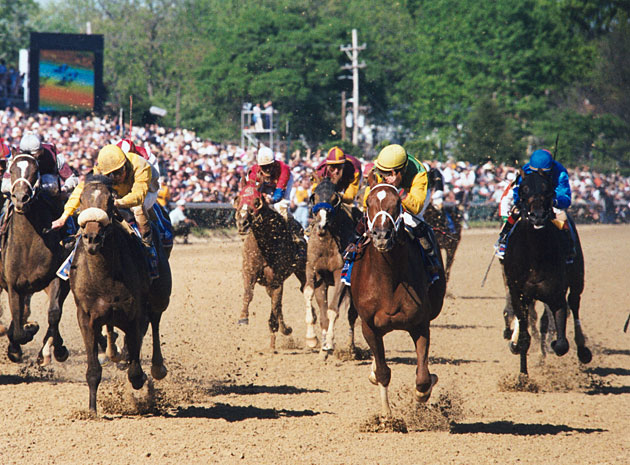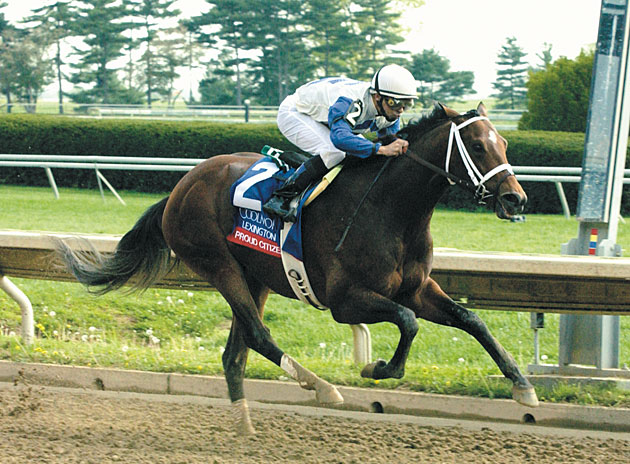Coolmore Lexington: A Prep in Its Prime

Can 15 years have really passed since two weeks between starts for 3-year-olds was considered optimal?
In 1999 trainer D. Wayne Lukas shipped Charismatic from Southern California—where he had run fourth in the April 3 Santa Anita Derby (gr. I)—to Kentucky for the April 18 Coolmore Lexington Stakes (gr. II).
Coming from just off the pace at Keeneland under Jerry Bailey, Charismatic won the 1 1/16-mile Lexington by 2 1/2 lengths as a 12-1 outsider.
"I thought his best races were when he came back quickly, so this was an ideal spot," Lukas said at the time. "I'd considered running him in an allowance race earlier in the week. I think the two-week schedule is a plus."
Then, two weeks after the Lexington, Bob and Beverly Lewis' Charismatic pulled off a stunning 31-1 surprise in the Kentucky Derby (gr. I) under the late Chris Antley.
But, as Bob Dylan sings, "things have changed."
Today the Lexington Stakes no longer serves as a prep for the Derby mainly due to the fact trainers prefer far more time between starts. Also, Churchill Downs' points system for entry to the Derby has lessened the importance of the Lexington as a main stop on the Road to Louisville.
Last year, when Churchill devised their points system for entry to the Run for the Roses, the Lexington was considered a "wild card" race worth 20-8-4-2 points (Keeneland's grade I Toyota Blue Grass is worth 100-40-20-10). This year's running of the Lexington has been downgraded even further to being worth only 10-4-2-1 points on the Derby trail, not enough to make an impact in this year's Derby field.
There was a time and place, however, when the Lexington perhaps superseded the Blue Grass as a steppingstone to the First Saturday in May. In the mid-to-late 1980s, about the time trainers' perceptions were changing and the Blue Grass Stakes was still run eight days—yes, eight days—before the Derby, the racing office at Keeneland developed what was the "Calumet purse" to the Lexington Stakes in 1984.
In 1985, Henryk de Kwiatkowski's Stephan's Odyssey won the Lexington and later ran second in both the Derby and Belmont Stakes (gr. I). Russell Reineman's Wise Times won the Lexington the following year, and while he didn't place in the classics, he did tear through the late-summer 3-year-old races, winning the Haskell Invitational Handicap (gr. I), Travers Stakes (gr. I), and Super Derby (gr. I) in succession. Tom Gentry's War won the Lexington in 1987 and wheeled right back in the Blue Grass 12 days later. War was edged by eventual Horse of the Year Alysheba in the Blue Grass but was elevated to first after a wild and wooly stretch run that included the late-running Leo Castelli.
Perhaps more than anything, the results of Keeneland's Derby preps in 1988 provided the impetus that helped flip the Blue Grass and the Lexington on the calendar. Louis Roussel and Ronnie Lamarque's Risen Star pulled off a slight upset of Claiborne Farm's Forty Niner in a scintillating running of the Lexington while Granacus and Intensive Command went one-two in a less-than memorable Blue Grass run in 1:52 1/5 for the nine furlongs. Risen Star, third in the Derby, would win 3-year-old championship honors after taking the Preakness and Belmont, and Forty Niner, the 2-year-old champion, would have a solid 3-year-old campaign. Few recall the fortunes of Granacus and Intensive Command.
The Blue Grass was moved to three weeks before the Derby while the Lexington slid down the April calendar to two weeks out. Once the race schedule was changed, the Blue Grass enjoyed a bit more success as a Derby prep, producing Preakness winner (and Derby runner-up) Summer Squall in 1990, and Derby winners Strike the Gold (1991), Sea Hero (1993), and Thunder Gulch (1995).
While Charismatic remains the last Lexington/Derby winner, Lukas used the Lexington as a springboard for Proud Citizen , winner of the Lexington in 2002 who ran second behind War Emblem under the Twin Spires; and Scrimshaw, the 2003 winner who ran third behind Derby winner Funny Cide in the Preakness.
Following Scrimshaw, Lexington winners didn't fare well under the Twin Spires. The next three winners from 2004-06, Quintons Gold Rush, Coin Silver, and Showing Up , had the following performances in the Derby: DNF, 12th, and sixth.
The installation of Polytrack came to Keeneland for the spring 2007 meet and changed the complexion of the race even more. Of the seven winners of the Lexington since then, only two have run in the Derby. Advice, the 2009 winner, ran 13th in the Derby—as did 2011 winner Derby Kitten.
The winner of this year's Coolmore Lexington Stakes won't make his way down I-64 to Louisville for the sport's biggest race on the first Saturday in May. However, with a $200,000 purse for 3-year-olds going 1 1/16 miles, it should continue to draw a deep cast of contenders and offer racing fans in Central Kentucky a challenge to handicap.
